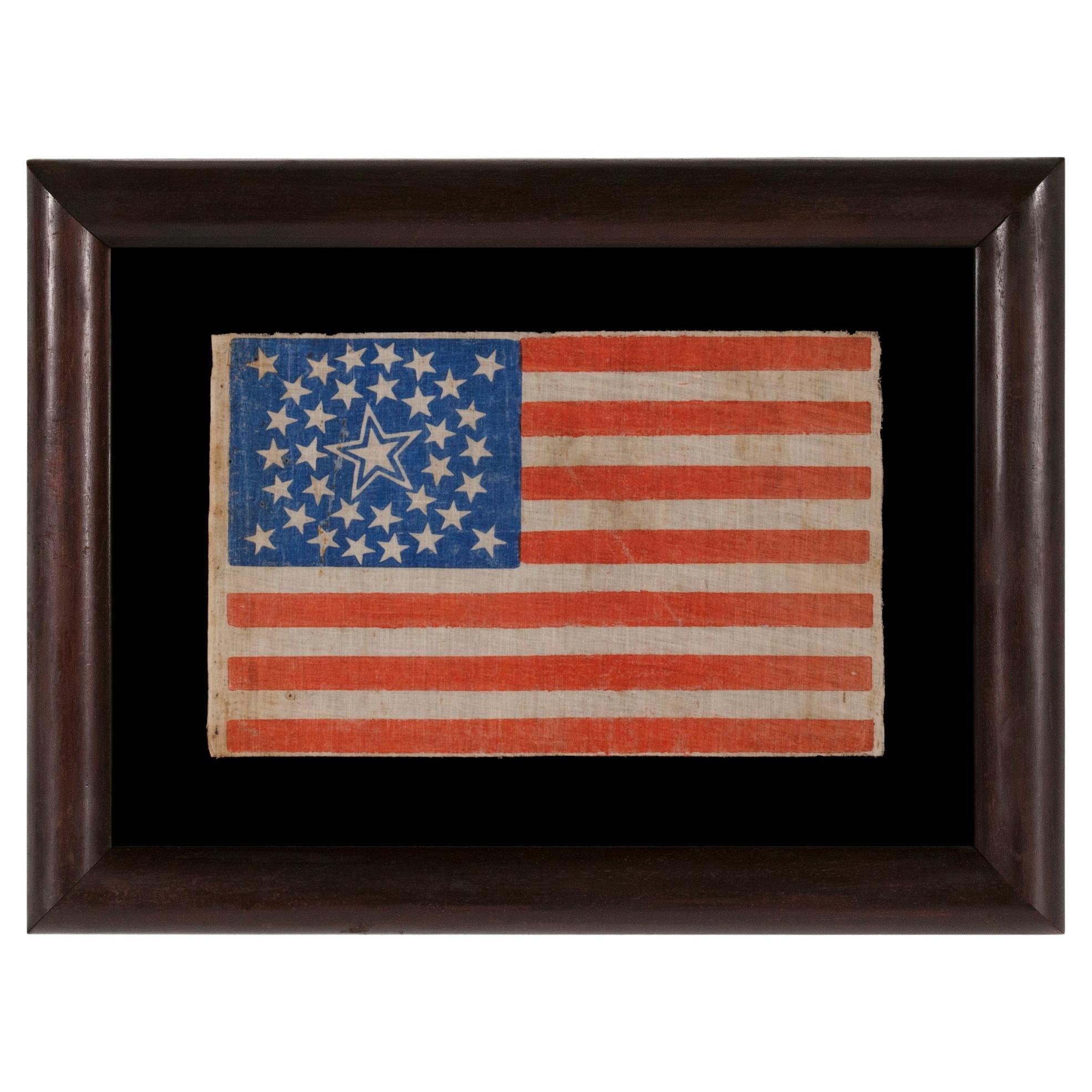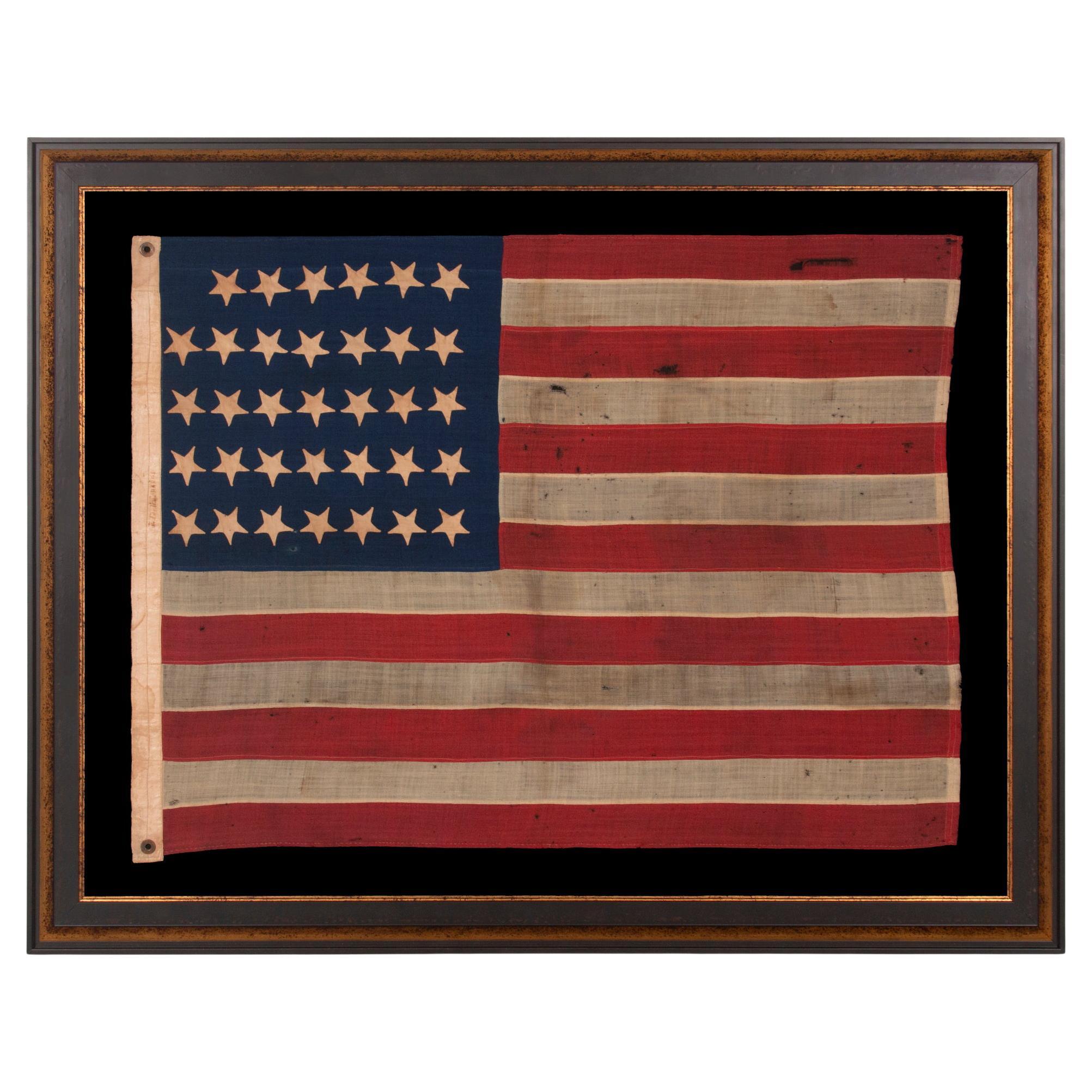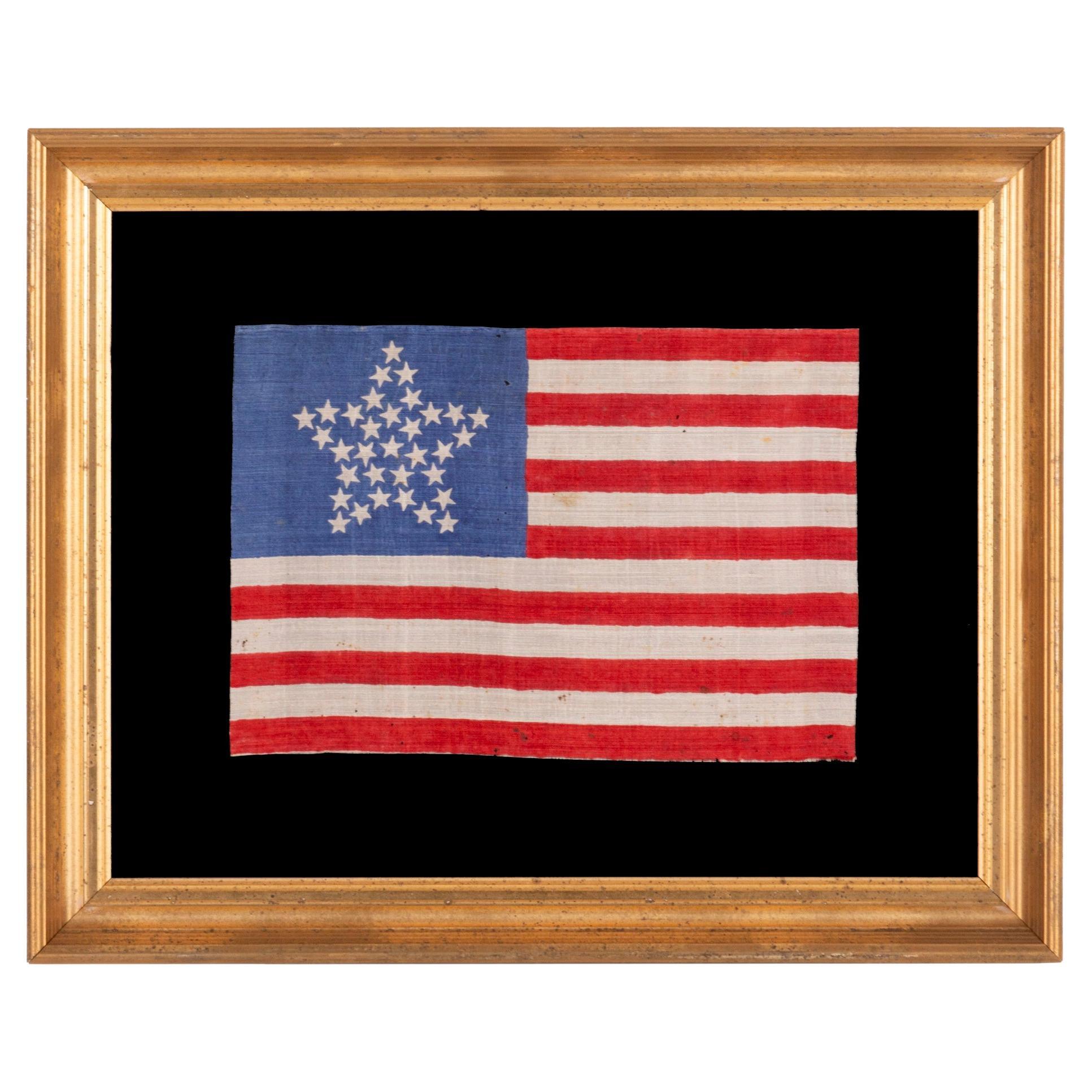Items Similar to 34 Star Antique American Flag with Hourglass Medallion Stars, ca 1861-1863
Want more images or videos?
Request additional images or videos from the seller
1 of 7
34 Star Antique American Flag with Hourglass Medallion Stars, ca 1861-1863
About the Item
EXTRAORDINARY 34 STAR ANTIQUE AMERICAN FLAG WITH AN ACCORDION OR HOURGLASS MEDALLION CONFIGURATION THAT SURROUNDS A PENTAGON OF STARS IN THE CENTER; MADE OF FINE SILK AND ENTIRELY HAND-SEWN; MADE DURING THE OPENING YEARS OF THE CIVIL WAR (1861-63), IN A TINY SIZE AMONG ITS COUNTERPARTS OF THE PERIOD; REFLECTS THE ADDITION OF KANSAS AS THE 34TH STATE
34 star flag of the Civil War period with an array of rare, beautiful, and otherwise desirable features. Extremely small among flags of this period with pieced and sewn construction, the flag displays a star pattern that is not only highly unusual, but unique to this particular example. This consists of a single star in the very center, surrounded by a pentagon of stars, flanked by angular bracket of three stars to either side. Above and below are rows of 5 stars, followed by rows of 6 that line the top and bottom of the canton. The resulting configuration is what I have termed an “accordion medallion,” though “hourglass medallion” or “standing bow tie” would be perfectly acceptable.
When rotated 90 degrees, to view the harder-to-identify, bow tie formation, students of early star patterns may note the visual similarity between this and what I call “Starburst” or “Crosshatch” medallions. The pattern, however, conspicuously lacks the crosses of St. Andrew (a saltire) and St. George (roman cross), that would allow it to be more accurately categorized as such.
Entirely hand-sewn, the canton and stripes of the flag are made of fine silk. The hemming of this was accomplished with great skill. The top and bottom edges are selvedge. These are so similar in nature as to have come from the same maker. There is a white, silk binding along the hoist, in the form of an open sleeve, through which a length of braided hemp rope was passed, expertly looped and re-braided into itself at the top and bottom for strength.
The stars are made of white, polished cotton. These were stitched to both sides (double-appliqued). Note how the edges of the fabric were not turned under, providing evidence of the fact that the maker was not especially skilled in appliqueing. This was common, as applique work was far more difficult than producing French seams.
In the 19th century, most flags with pieced and sewn construction were 8 feet long and larger. A six-footer was considered small. Even military battle flags, carried on foot, measured 6’ x 6.5’, which translates into approximately 7’ x 7.5’ after framing, about the size of an average quilt and larger than can comfortably fit on a wall in a house with 8-foot ceilings and average width baseboard. Flags smaller than this were produced both commercially and at home, but the smaller they are, the more unusual they are. At just 26.5 x 46.5 inches, this flag is extremely small for a Civil war period flag with sewn construction.
Silk was both beautiful and lightweight, which made it elegant for military unit colors and preferable for flags meant to be carried on foot. Most outdoor use flags were made of wool bunting, a fabric peculiar to flag making, that was not used in the making of clothes or upholstery work. Wool sheds water. Cotton absorbs water, making it heavy and subject to rot. Silk was both fragile and inadvisable to expose to water, and the way in which it was sold, in the latter 19th century, led to an inordinate amount of fabric breakdown and loss.
The size of the flag, while not precisely conforming to U.S. Army regulations, would adapt well enough for use as a guidon, but the rope hoist was not typical for flags carried on foot.
If flown on land, this flag was more likely to have been run up a flagpole on a pulley system. Because it was too small to be effective as a signal on a building of significant size, it was more likely to have been employed at the headquarters of an officer. Though well cared for, the flag displays precisely the sort of losses I would expect of a flag that was flown outdoors for an extended period of time. Note the losses at the top and bottom of the hoist binding, as well as along the fly, including in the upper and lower corners. Because silk was costly and in short supply during wartime, it is likely that the recipient of the flag was someone of high stature. Whatever the case may be, the size, fabrics, Civil War date, and its unique star configuration, combine to make it an exceptional example of the period.
Kansas was admitted into the Union as the 34th state on January 29th, 1861, about two-and-a-half months before the Confederate assault on Fort Sumter that marked the beginning of the Civil War. Though the 34th star was officially added on July 4th of that year, no one cared about official star counts and most flag makers would have added a 34th star with the addition of the state earlier that year. 34 star flags would have been produced until the addition of West Virginia in June of 1863, shortly before the Battle of Gettysburg. The 34 star count remained official until July 4th, 1863. Because production was heaviest during the war’s opening two years, 34 is the most common star count seen on Civil War flags.
Mounting: The flag was mounted and framed within our own conservation department, which is led by expert staff. We take great care in the mounting and preservation of flags and have framed thousands of examples.
The background is 100% cotton twill, black in color, that has been washed and treated for color fastness. The black-painted, hand-gilded and distressed molding is Italian. The glazing is U.V. protective acrylic.
Condition: There are minor to modest losses in the striped field, most notably at the fly end in the 1st, 4th, 8th, 12th, and 13th stripes. There are three areas of modest loss near the bottom, hoist end corner, in the last two white stripes. Fabric of similar coloration was placed behind some of these areas during the mounting process, for masking purposes. There are minor losses along the hoist binding, accompanied by moderate occurrences at the top and bottom, caused by the stress of being flown and contact with the coarse rope. There is very minor to modest soiling in limited areas and there is moderate fading of the red silk fabric. Many of my clients prefer early flags to show their age and history of use.
Frame Size (H x L): 38" x 56.5"
Flag Size (H x L): 26.5" x 46.5"
- Dimensions:Height: 38 in (96.52 cm)Width: 56.5 in (143.51 cm)Depth: 2.5 in (6.35 cm)
- Materials and Techniques:
- Place of Origin:
- Period:
- Date of Manufacture:1861-1863
- Condition:See Item Description.
- Seller Location:York County, PA
- Reference Number:
About the Seller
5.0
Recognized Seller
These prestigious sellers are industry leaders and represent the highest echelon for item quality and design.
Established in 1991
1stDibs seller since 2008
61 sales on 1stDibs
Typical response time: 10 hours
- ShippingRetrieving quote...Ships From: York County, PA
- Return PolicyThis item cannot be returned.
More From This SellerView All
- 34 Star Antique American Parade Flag, Kansas Statehood, ca 1861-1863Located in York County, PA34 STARS IN A MEDALLION CONFIGURATION ON AN ANTIQUE AMERICAN PARADE FLAG WITH A LARGE, HALOED CENTER STAR; CIVIL WAR PERIOD, KANSAS STATEHOOD, 1861-1863 34 star American national pa...Category
Antique 1860s American Political and Patriotic Memorabilia
MaterialsCotton
- 34 Star Flag with Upside down Hand Sewn Stars, Kansas Statehood, ca 1861-1863Located in York County, PA34 Upside-down, Hand-sewn Stars In A Notched Configuration, On An Antique American Flag Of The Civil War Period, With A Beautiful And Highly Unusual Jacquard Weave Binding, And In A Tiny Scale Among Its Counterparts, Reflects The Addition Of Kansas As The 34th State, 1861-1863 34 star American national flag with a number of interesting and desirable features. Chief among these is the scale of the flag among counterparts of the period. At just three by four feet, its size is absolutely tiny among those with pieced-and-sewn construction. During the 19th century, sewn flags (as opposed to those that were printed on cloth) were typically eight feet long and larger. This is because they were important in their function as signals, meaning that they needed to be seen and recognized from great distance. A flag that was six feet in length was considered small and production of flags smaller than this was extremely limited. Even infantry battle flags, carried on foot, were approximately six by six and-one-half feet, about the size of an average quilt of the same period. It wasn't until the 1890’s that manufacturers began to produce smaller sewn flags in great quantity. The stars of the flag are arranged in justified lineal rows, the first of which contains one fewer star. This results in what I call a “notched” design, leaving one space open for the addition of another star. The blank space leaves little doubt that the maker of the flag assumed that another Western Territory would soon acquire statehood, or that West Virginia might soon break free from Virginia, which occurred in June of 1863. Note how the stars are oriented so that they are upside-down on their vertical axis, with two points up instead of one. No one knows if this positioning bore any particular meaning. Both modern notions of the correct orientation of a star, and the present official design of the American flag, dictate that the stars are supposed to have one point up. Since there was no official design for the flag until 1912, however, it may simply be that the maker of the flag did not consider any particular position to be right-side-up or upside-down. In the mid-19th century, it was not uncommon to see stars pointing any which way, varied throughout whatever arrangement was chosen. Whatever the case may be, the feature present on this particular flag is unusual to the eye and notable in terms of its presentation. Made of cotton, the stars are hand-sewn and double-appliquéd (applied to both sides). The canton and stripes of the flag are made of wool bunting. Because blue wool bunting generally came in a width of 18", the canton was pieced from two lengths of fabric, joined by hand-stitching. The canton is joined to the striped field by hand-stitching. The stripes are pieced and hemmed by treadle stitching. Made of heavy, polished, jacquard weave linen, the binding of the flag is both exceptional from a textile connoisseur’s perspective and highly unusual. This is joined to the flag by treadle stitching. There are two brass grommets, one each at the top and bottom of the hoist, which are likewise especially unusual, in that they are both heavier than normal and intentionally hammered flat. I have seen this on only one other occasion in a Civil War flag...Category
Antique Late 19th Century American Political and Patriotic Memorabilia
MaterialsWool
- 34 Star Antique American flag, Kansas Statehood, Civil War Period, ca 1861-1863Located in York County, PA34 STAR ANTIQUE AMERICAN FLAG OF THE CIVIL WAR PERIOD (1861-63), WITH WOVEN STRIPES, PRESS-DYED STARS, AND BEAUTIFUL COLORS, POSSIBLY MADE IN NEW YORK BY THE ANNIN COMPANY, REFLECTS THE ADDITION OF KANSAS TO THE UNION, 1861-1863 34 star flag of the Civil War period, with a press-dyed canton and woven stripes. Made of a fabric produced frame a combination of wool and cotton fibers, the 34 star count was achieved in an unusual fashion, beginning with a press-dyed field of 32 star...Category
Antique 1860s American Political and Patriotic Memorabilia
MaterialsCotton
- 13 Star Antique American Flag with Hand-Sewn Stars in 5-3-5 Pattern, ca 1861-65Located in York County, PAAntique American flag with 13 hand-sewn stars in an extremely rare lineal configuration of 5-3-5, probably made with the intent of use by local militia or private outfitting of a vol...Category
Antique 1860s American Political and Patriotic Memorabilia
MaterialsWool
- 33 Star Flag with Stars in a "Great Star" Pattern, Oregon State, ca 1859-1861Located in York County, PA33 STARS IN A "GREAT STAR" PATTER ON A BRILLIANT, ROYAL BLUE CANTON, A RARE AND EXTRAORDINARY EXAMPLE, PRE-CIVIL WAR THROUGH THE WAR'S OPENING YEAR, 1859-1861, OREGON STATEHOOD 33 s...Category
Antique Mid-19th Century American Political and Patriotic Memorabilia
MaterialsSilk
- 36 Star Antique American Parade Flag, with Canted Stars, ca 1864-1867Located in York County, PA36 STAR ANTIQUE AMERICAN PARADE FLAG WITH CANTED STARS IN DANCING ROWS, ON A BEAUTIFUL, CORNFLOWER BLUE CANTON; CIVIL WAR ERA, NEVADA STATEHOOD, 1864-1867 36 star antique American f...Category
Antique 1860s American Political and Patriotic Memorabilia
MaterialsCotton
You May Also Like
- 34-Star Civil War American Flag, Antique Great Star Pattern, circa 1861Located in Colorado Springs, COThe stars of this extremely rare, Civil War-era flag are arranged in what is sometimes called the "Great Flower" pattern, a large star made out of smaller stars -- named as such beca...Category
Antique 1860s American Political and Patriotic Memorabilia
MaterialsLinen
- 39-Star Antique American Flag with 'Whimsical' Star Pattern, 1889Located in Colorado Springs, COThis is a 39-star unofficial American flag, handmade and printed on cotton. The flag dates to 1889 and has a unique history, thanks to its rare star-count. The flag’s canton is prin...Category
Antique 1880s American Political and Patriotic Memorabilia
MaterialsCotton
- 36-Star Printed American Flag, Rare Haloed Star Medallion, Circa 1865Located in Colorado Springs, COThis 36-star flag has stars arranged in a gorgeous and highly desirable medallion pattern. This particular medallion includes a large haloed star in the middle, two rings of stars s...Category
Antique 1860s American Political and Patriotic Memorabilia
MaterialsFabric
- 38-Star Antique American Flag with Unique Canton, circa 1876-1890Located in Colorado Springs, COThis is a striking 38-star American flag. The flag dates to 1876-1890, when Colorado (represented by the large star in the center of the flag’s canton) joined the Union as the 38th s...Category
Antique Late 19th Century American Political and Patriotic Memorabilia
MaterialsMuslin
- 46-Star American Flag Printed in Drum Star ConfigurationLocated in Colorado Springs, COThis is an original 46-Star American parade flag, celebrating Oklahoma statehood. Each star on the flag's canton represents a state in the Union at the time. The official flag design would update every July 4th, to include any new states added to the Union in the past year. Oklahoma, the 46th state, entered the Union on November 16, 1907. As such, this 46–star flag was the official flag of the United States from July 4, 1908, until July 4, 1912. The silk flag has a dark blue canton with 46 white printed stars. The stars are printed in an 7-8-8-8-8-7 row configuration, or “Drum design.” The flag design is completed with 13 alternating red and white stripes, each stripe representing one of the original thirteen colonies. The land that comprises Oklahoma today was added to the United States as part of the Louisiana Purchase of 1803. Throughout the 19th century, the U.S. government relocated Indian tribes from the southeastern United States to the area, and by 1900, over 30 Indian tribes had been moved to what was originally called the Indian Territories. At the same time, ranchers in Texas began to move into the area in search of new pasture lands. Although stipulations in the Indian Relocation Act agreed that the land would forever be Indian Territory, the promise of fertile farmland trumped the government’s promise of sovereignty. On April 22, 1889, they opened the land to settlement by homesteaders, creating a land run in which settlers, called “Boomers,” were allowed to cross the Texas or Arkansas border at a particular hour to claim homesteads. Settlers who illegally crossed the border earlier to stake prime land were called “sooners,” which eventually became the state’s nickname. Wagons and the Santa Fe railroad carried cartloads of men and women to blank town sites and building plots, creating ten thousand-people communities in a matter of days. The following year, the region was further divided into Indian Territory and Oklahoma Territory...Category
Vintage 1910s American Political and Patriotic Memorabilia
MaterialsSilk
- Early 20th C. Monumental American Flag with 48 Stars, c.1940-1950Located in San Francisco, CAAbout This is an original monumental American flag made with 48 hand sewn stars and stripes. It is in good condition and has brass grommets to hang. Creator unknown. Date of m...Category
Early 20th Century Industrial Political and Patriotic Memorabilia
MaterialsBrass
Recently Viewed
View AllMore Ways To Browse
Antique Accordion Case
Sergeant Sailor
Wilson Brothers Items
G Sergeant Antiques
Wreath Outdoor
Distressed Debt
Folk Art Felt Pennant
Antique American Flag 49 Stars
California Republic Vintage Flag
Chinese Porcelain Lunch Box
Toy Sewing Machine
Uss Utah
A Moderate Gale
Antique Jewelry Lancaster Pa
Carved Wood Birds
Eagle Of The French National Guard
Grand Duchess Tatiana
Hermes Folk Art Scarf





